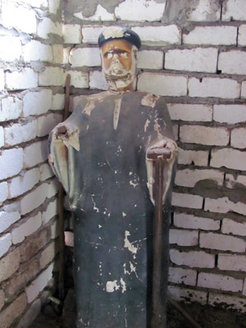Icons and Iconoclasm: Dying to the World
by Angie Heo
During their earthly lives, Coptic saints must preserve their humility and protect themselves from worldly 'vainglory' (al-magd al-batil, Arabic). One monk, Abdel-Masih al-Manahri (d. 1963) who hails from an Upper Egyptian village in Minya, is fondly remembered among Coptic Christians all over the world for his loud, flamboyant acts of self-effacement. ‘I want to get married!’ ‘Don’t thank me!’ ‘I don’t know my name!’ In the aftermath of his miracles, outbursts like these, of impossible desire and possible insanity, served as warnings to the witnessing public. An idolatrous excess of recognition is hardly worth the loss of eternal salvation.

Death is the point of spiritual release, the point at which the iconic reproduction of holiness explosively begins. After saints die, they are ‘freed from the battle against Satan.’ Others are, in turn, freed to publish their holy lives through texts and recordings, in creative memory of those special dead created in the image of God. In the shrine of Abdel-Masih al-Manahri, the small cave where he had once lived, an efflorescence of his various portraits [Figure 1] plaster the walls. With his plaintive eyes and crooked smile, the departed saint looks out from all directions. Copts come to seek his prayers, leaving behind traces of themselves which hang from the ceilings in large nets: photos of the ill, lettered requests, small gifts of devotion. Now you can finally speak and write the saint’s name - because he is long gone, safe in heaven.

Behind the shrine, across lush fields of wheat and ink-colored cattle, there is an alcove that reminds visitors that limits to holy likeness continue on, even after death. De-faced and de-limbed, a shattered statue of Abdel-Masih al-Manahri displays the remnants of iconoclasm [Figure 2]. One villager explained to me with simplicity, ‘We don’t worship statues (asnam), this is against teachings of the Church.’ Signs of iconoclasm hint at sensed forms which just come too close, too ‘life-like.’ Matters of salvation are more than ciphers of clerical legitimacy; they concern the very nature of heavenly representation. If prayer works for the good of those who remain on earth, then acts of image destruction expose points where sin is prone to occur. The saint is not here any longer, so don't forget that he died. Iconoclasm represents the memory that he lives on in heaven, only on the very practical condition that he has left the world. For it is not merely Abdel-Masih who risks the spiritual dangers of vanity, but also his many followers who pray in his wake.













